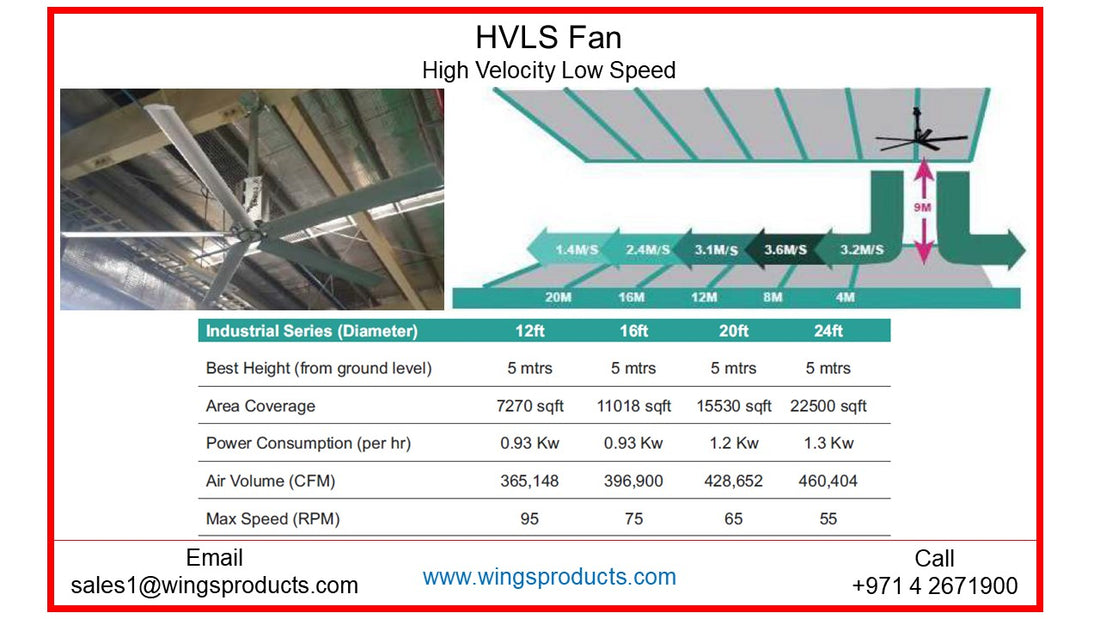A high-volume low-speed (HVLS) fan is a type of mechanical ceiling fan greater than 2.1 m in diameter. HVLS fans move slowly and distribute large amounts of air at low rotational speed. Hence the name "High Volume, Low Speed".
HVLS fans are used in industrial and commercial setups. In industries, air conditioning is often cost prohibitive or impractical, and is usually used for refrigerated warehouses. HVLS fans installed in spaces like warehouses, barns, hangars and distribution centers can prevent heat stress, which leads to increasing worker comfort and hence productivity. HVLS fans are also used in commercial spaces, where air conditioning is more common, but increased air movement from the top can cost-effectively augment occupant comfort or prevent stratification. It is typically used in commercial establishments such as shopping malls, churches, offices, airport terminals, fitness centers and schools.
How HVLS fans work
HVLS fans work on the principle that cool air breaks up the moisture-saturated boundary layer surrounding the body and accelerates evaporation to produce a cooling effect. HVLS fans produce a column of air as they turn. This column of air moves down and out along the floor. Called a horizontal floor jet, this deep wall of horizontal moving air is relative to the diameter of a fan, and to a lesser degree, the speed of a fan. Once the floor jet reaches its potential, it migrates outward until it meets a side wall or other vertical surface.
Under ideal conditions, a 2.4 m diameter fan produces a floor jet of air approximately 90 cm deep. A 7.3 m diameter fan produces a floor jet 270 cm deep, tall enough to engulf a human standing on the floor.
Heating and cooling benefits
Air movement can have a significant influence on human thermal comfort. Wind chill in cold conditions is considered detrimental, but air movement in warm environments such as UAE is considered beneficial. This is because normally under conditions with air temperatures above about 23°C, the body needs to lose heat in order to maintain a constant internal temperature.
Unlike air conditioners, which cool rooms, fans cool people. HVLS fans increase air speed at the occupant level. This facilitates more efficient heat rejection resulting in cooling the occupant rather than the space. Elevated air speed increases the rate of convective and evaporative heat loss from the body, thus making the occupant feel cooler without changing the dry bulb temperature of the air.
Large fans versus small fans
Larger diameter fans can move more air than smaller fans at the same speed. A turbulent, high velocity air jet dissipates very quickly. A large column of air, however, "travels" farther than a small column of air. The friction between the moving air and stationary air occurs at the periphery of the moving column. The perimeter of a large air column has proportionately fewer peripheries, and hence less drag.
When the down column of air from an HVLS fan reaches the floor, the air turns in the horizontal direction away from the column in all directions. The air flowing outward is called the "horizontal floor jet". Since the height of the floor jet is determined by the diameter of the column of air, a larger diameter fan naturally produces a larger air column and thus a higher floor jet. Smaller high-speed fans of equivalent displacement are incapable of producing the same effect.
Airspeed, combined with fan "effectiveness", means that when the objective is to cool people, HVLS fans are more efficient and effective than small high-speed fans.
